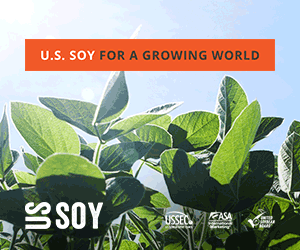(Editor’s note: This is the seventh and final installment in our seven-part in-depth editorial series where we look ahead at “Farm & Food 2040.” This story focuses on the growth opportunities for U.S. commodities abroad in the next two decades.)
If there’s one certain thing, it’s that American farmers, with the aid of technological innovation, will continue to be some of the most prolific food and fiber producers in the world. That’s why, especially in an increasingly volatile trade landscape where major importers can just shut their doors to U.S. commodities overnight, farm groups are scouring the globe and painstakingly laying the groundwork for trade over the next two decades.
“We’re seeing the potential for a 30 percent increase in grain production in the next 20 years, so we need … additional markets,” says U.S. Grains Council Director of Global Strategy Kurt Schultz. “You have growing production and you want diversification of markets to take away the shock of trade wars or unilateral action by one country.”
The U.S. is already the largest agriculture exporter in the world, selling its beef to Japan, its oranges to Canada, and its wheat to Mexico, but where are the future markets to accommodate the ever-increasing and higher-yielding production from America’s farms and ranches?
Here’s a snapshot from U.S. industry representatives who are staking the futures of their producers on where the demand will be 20 years from now: The Saudis will be feeding their cows with grains grown in Illinois and Iowa. Mexicans will be peeling juicy Californian oranges. The Chinese will be dining on beef from Kansas cattle. Tanzanians will be importing Nebraskan corn. The Koreans will be munching on crisp apples from Washington orchards. Bangladeshis will be making T-shirts out of cotton from Texan fields. Zimbabweans will be dining on chickens raised in Delaware.
Most of these countries buy little or no farm commodities from the U.S. now, but the potential is there and that’s why officials like USGC President and CEO Tom Sleight say they are starting to plant the seeds of opportunity.
Africa
People tend to wriggle their eyebrows in skepticism when Sleight talks about the massive potential of the African continent, but he doesn’t care. He — and many others — see a similarity in the dynamics at work there that were present 20 or 30 years ago in China.
In other words, he sees massive market potential where there isn’t much now. “We see some real opportunity there that needs to be massaged right now because it’s going to grow later on,” Sleight told Agri-Pulse.

Tom Sleight, U.S. Grains Council
USGC, the U.S. Poultry and Egg Export Council and the U.S. Soybean Export Council are all spending time and resources in Africa, especially in the more populous areas of East and West Africa, where salaries and meat consumption are starting to rise. Corruption and poverty are still ever-present in nations with governments that are still very wary of foreign goods that they see as a threat to domestic producers, but all of that is conquerable, says Schultz.
And USGC is starting with the Tanzania poultry industry, showing producers in the largest country in East Africa they can produce world-class eggs and chicken with the proper investment and access to U.S. feed grains.
The project, Schultz said, has been a success and that goes a long way toward showing poultry producers and political leaders there and in neighboring countries that success breeds success and none of that is possible with closed borders.
“If you don’t have an open market for importing grain, you’re going to be limited by what you can produce domestically and that’s currently what the problem is in all these countries — these very protectionist markets,” Shultz said. “We need to convince the local industry that they can benefit by importing raw materials, whether it be poultry houses, refrigeration or feed grains in order for their industry to grow.”
Africa is also where the U.S. Meat Export Federation is stepping up its long-range activities, using countries like South Africa and Morocco — two countries that recently opened to U.S. beef and pork — as stepping stones to other markets that will hopefully become big customers years from now.
“Africa is a good example of a region where we still don’t have much product going there, but it looks a lot like Central America did years ago,” said Joe Schuele, USMEF’s communications director. “You need a critical mass of markets in the region that feel like they offer us sustainable business.”
USDA Chief Economist Rob Johansson agrees that Africa, especially the Sub-Saharan countries, will offer substantial markets in the future, but he cautioned that lack of political cohesion across the many sometimes unstable governments will be a limiting factor that sets the continent apart from markets in China or India.
“China has one national voice,” Johansson told Agri-Pulse. “Sub-Saharan Africa has different governments and it’s been a challenge for a lot of those countries to generate sustained economic growth. We expect higher rates of growth in Africa over the next 20 or 30 years. Is it going to be as high as China or India? Maybe not, but it’s going to be a big market for us eventually.”
East Asia
China, already the largest agriculture commodity importing nation in the world, is a dream market for the U.S. beef industry and has been for years because of the sheer numbers. Twenty years from now, U.S. packers can already envision sending hundreds of millions of dollars worth of beef to China. That’s definitely possible Schuele said, but only if U.S. exporters can get a fair crack at sales.
“China is the fastest growing beef import market in the world and the momentum has not slowed,” Schuele said. “They’re importing more and more beef from just about every supplier, but we’ve largely been on the sidelines because of the product restrictions.”
The U.S. and China continue to square off in a trade war that started about one year ago when the U.S. hit China and many other countries with steel and aluminum tariffs. Since then the tariffs have escalated sharply, halting most U.S. ag exports. Chinese retaliation also halted U.S. beef exports, but there wasn’t much to put a stop to.
Much fanfare was made in the summer of 2017 about the Chinese agreeing to end their 20-year-old ban on U.S. beef, but the breakthrough was not substantial because China continued to maintain severe restrictions like a ban on hormone-treated product.
“If we could get a level of access to China like we have elsewhere in Asia, there’s no question (China) would be a top market," Schuele said. "I don’t think there’s any question that if we had access at the same level as Japan and Korea, we could surpass those two markets. From the demand standpoint, absolutely.”
The U.S. shipped about $1.7 billion worth of beef to Japan and the same amount to South Korea last year. For a comparison, the U.S. was forecast to export about $80 million of beef to China in 2018, but sales only reached about $60 million because of Chinese tariffs.
South Asia
India perhaps represents the largest market of the future for U.S. agriculture commodities, but the country’s onerous tariff and non-tariff barriers as well as extensive subsidies aimed at propping up domestic producers will make it nearly impossible for expanded trade in many farm goods in the near future.
But that doesn’t mean farm groups ranging from the U.S. Grains Council to the U.S. Poultry and Egg Export Council are not laying bets on the future of India, the second most populous country in the world.
“Where’s the next China for us?” USDA Trade Counsel Jason Hafemeister asked rhetorically in a recent USDA audio posting. “Where are we going to find the next big bump? India’s a great place to look. There’s a billion people in India. They have real production constraints in agriculture.”

Jason Hafemeister, USDA
But he also warned that India’s potential to be a “big bump” for U.S. exporters won’t likely be coming any time soon.
“It’s hard to be optimistic in the short term that we’ll just crack the market wide open, but it’s certainly a place where we need those opportunities and when India is in a position to negotiate … we want to be prepared for them.”
As it stands now, recent aggression from the Trump administration could push the U.S. and India further into a multi-pronged trade dispute or result in talks that bring the nations closer together.
Last year, the U.S. hit India with steel and aluminum tariffs, prompting retaliation on U.S. apples and lentils. And earlier this month the U.S. Trade Representative, claiming India was failing to provide the U.S. “equitable and reasonable access” to its markets, announced it was terminating the country’s designation under the Generalized System of Preferences program, which allows some exports to enter the U.S. duty-free.
But USDA Undersecretary for Trade and Foreign Agricultural Affairs Ted McKinney, who has led two ag trade delegations to India, says he’s still optimistic that the country will eventually be opened wide to U.S. farm goods. U.S. poultry and cotton exporters are equally optimistic.
“We expect India to be a tremendous market,” USAPEEC President Jim Sumner told Agri-Pulse. “Not only are we seeing a rising middle class, we’re seeing a westernization of their food consumption patterns.”
Sumner says recent outbreaks of avian influenza have bolstered his expectations that the country will need U.S. supplies, but he also stressed that the threat of avian influenza isn’t isolated to India. The poultry sectors in all developing countries are at great risk, a situation he says could put massive strains on producers in just a handful of countries (mostly the U.S. and Brazil) to supply more and more chicken, turkey and eggs in the years to come.
“Whenever you have countries that have huge populations in dense areas, people are going to try to grow their own poultry in their backyards and you’re going to have a biosecurity problem that’s going to support the spread of diseases,” Sumner said. “It could come down to a couple of countries 20 years from now that have to supply the world.”
If that happens, he stressed, the world is going to have to move beyond concerns over production practices in large operations.
“We're going to have to use every tool that is available,” he said. “We can’t be worried about genetically modified this or genetically modified that. We’ll need to use every trick in the book for us to even begin to consider feeding the global population in 20 years.”
Perhaps also driving some of the optimism about India’s future are the few successes already in cracking the country’s massive demand. India, until the U.S. hit it last year with steel and aluminum tariffs, was the second largest export market for U.S. apples. The country is also a major importer of products like ethanol. India was the third largest foreign market for U.S. ethanol last year, buying about 157 million gallons of the corn-based fuel, according to the Renewable Fuels Association.
Mexico
While India may hold massive market potential for U.S. commodities like poultry and ethanol, California Citrus Mutual President Joel Nelson says he doesn’t see a future for citrus. The country has been open to U.S. oranges for 20 years, but U.S. sales have never amounted to much and likely never will due to the country’s refusal to budge on seemingly intractable bureaucracy and sanitary and phytosanitary barriers.
The biggest push with an eye to the far future for citrus exporters, Nelson told Agri-Pulse, is Mexico. The closest foreign neighbor for California farmers is also one of the least penetrated, but the potential is there and Nelson said his group is slowly, methodically laying the groundwork.
Unlike India, the biggest obstacle in Mexico is purchasing power, and that has the potential to change with improvements in the middle class and more disposable income.
Canada, to the north, is the largest foreign market for California citrus. That’s because, unlike in Mexico, Canadians can spend a little extra to pay for high-quality oranges from the Golden State.
“We’re working with the high-end resorts and good restaurants and we’re working the food service operations in Mexico so that the middle class and upper middle class have an opportunity to taste our fruit and appreciate the consistency, flavor and quality," Nelson said. "The hope is this transforms into a demand in the supermarket. That’s how we’re starting there … You gotta approach these things with an introductory offer, so to speak.”
Middle East
While the Middle East holds virtually no promise for citrus because of plentiful supplies of cheap fruit from Turkey and South Africa, the U.S. Grains Council is betting big on the future of markets in countries like Saudi Arabia.
As water becomes scarcer and populations swell in the Middle East, countries there are going to be forced to have to rely more and more on imports to support the growing meat and dairy industries, says USGC’s Schultz.
“Saudi Arabia is under extreme pressure to reduce its water consumption for agriculture, and they have very large dairy and poultry operations that really need to import feed grains in order to keep those industries growing and expanding,” he said. “They need to move away from using subsidies to produce forage in the desert.”
The same view applies to Turkey, Iran, Iraq and Egypt, where “water is increasingly going to be a scarce commodity and they are better off producing higher-value products for human consumption than … growing cereal,” Schultz said.
The Middle East is also a target for the U.S. wheat sector, which is counting on a growing middle class that will want a higher quality and more diverse selection of bread. Russia and its expanding wheat fields may be dominating the market for cheap grains, but there’s no beating the U.S. when it comes to quality and diversity.
“New opportunities exist, even in these markets where Russian supplies dominate the price conscious government imports,” a spokesman for the U.S. Wheat Associates said. “There is growing demand in the private sector for niche premium bread products requiring higher gluten strength flour and confectionary products best made with flour from soft wheat classes. This creates new opportunities for U.S. hard red winter, hard red spring, soft red winter and soft white wheat imports.”
And the USW isn’t going to sit around to wait for the Middle East to come knocking.
The USW “will work with specific private mills to make recommendations on how to produce the right types of flour for these markets, and with bakers to demonstrate how to evaluate their flour and produce better quality end products more efficiently,” the spokesman said.
The World
U.S. farmers and ranchers depend too much on China to buy their soybeans, sorghum, cherries, oranges, almonds and cheese. That has increasingly become the message from Trump administration officials like Agriculture Secretary Sonny Perdue as the ongoing trade war with China heated up.
“I’m concerned that we have become too dependent on a major customer there that doesn’t have our best national interests in there thinking,” Perdue told reporters earlier this year as Chinese retaliatory tariffs — responses to U.S. tariffs — cut off a wide swath of U.S. ag exports.

Chuck Conner, National Council of Farmer Cooperatives
But that kind of thinking makes no sense, according to Chuck Conner, CEO of the National Council of Farmer Cooperatives and a former USDA deputy secretary during the George W. Bush administration.
“I’m not buying into the notion that somehow we have to diversify the Chinese market or any other market that is substantial for us because that implies that somehow we put all of our resources into developing that market,” Conner told Agri-Pulse. “The Chinese market developed not because we pushed to develop it on this end as much as it is the demand was there and we are going to sell where there’s demand. You’re never going to have a U.S. exporter say, ‘You represent too big of a share of our market. Go get your soybeans somewhere else.’”
But regardless of the reason, U.S. farmers and ranchers are reaching into every corner of the globe to sell their crops to everyone who can buy them.
“Where ever you’re adding more people, we’ll be selling more to them,” USDA’s McKinney told Agri-Pulse.
And while most U.S. farm groups looking to expand global markets would readily agree with that sentiment, they also agree that much more needs to be done to convince those foreign nations that the impulse to protect their producers from imports can be the worst thing for them in the long run.
Schultz points to Mexico as a prime example: “You look at Mexico pre-NAFTA and post-NAFTA. Their livestock industry is now four times larger. After NAFTA they had access to feed grains and they could grow without limit. Open trade doesn’t kill industry. It helps (industry) grow.”
For more news, go to: www.Agri-Pulse.com.



